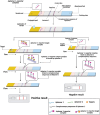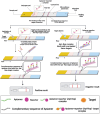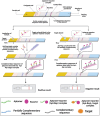From lab to field: revolutionizing antibiotic detection with aptamer-based biosensors
- PMID: 40476227
- PMCID: PMC12138339
- DOI: 10.1039/d5ra02100f
From lab to field: revolutionizing antibiotic detection with aptamer-based biosensors
Abstract
Antibiotics were initially discovered for their medicinal applications, however, since their introduction, the usage of antibiotics has expanded beyond clinical settings into various sectors, including agriculture, aquaculture, and animal husbandry. In these fields, antibiotics have often been employed non-judicially, primarily as growth promoters or preventative measures against infections, rather than strictly for therapeutic purposes. This widespread and often indiscriminate use has resulted in significant repercussions for both the environment and public health. The accumulation of antibiotics in soil and water ecosystems has led to alterations in microbial communities, fostering the emergence and proliferation of antibiotic-resistant bacteria (ARB). As these resistant strains circulate through various environmental pathways, they pose a growing threat not only to animal health but also to human health. Thus, the need for rapid, highly sensitive, and affordable detection platforms for ARB diagnostics has become urgent. Up to now, many analytical methods have been reported for the determination of antibiotics, such as HPLC, LC-MS, GC-MS, capillary electrophoresis-MS, etc. But these techniques are expensive, time-consuming, and demand trained operators. The aptamer based biosensors circumvent these problems and could ensure fast on-site analysis of antibiotics. In this review, we discuss how nucleic acid aptamer functionalized nanoparticles emerged as a sanguine answer to overcome the limitations of traditional detection modalities. Moreover, the latest advancement in the development of lateral flow assay, colorimetric, chemiluminescent, surface plasmon resonance, fluorescence and electrochemical biosensors for antibiotics detection have also been explored.
This journal is © The Royal Society of Chemistry.
Conflict of interest statement
There are no conflicts to declare.
Figures















Similar articles
-
Electrochemical Biosensors for the Detection of Antibiotics in Milk: Recent Trends and Future Perspectives.Biosensors (Basel). 2023 Sep 1;13(9):867. doi: 10.3390/bios13090867. Biosensors (Basel). 2023. PMID: 37754101 Free PMC article. Review.
-
Advances in the Application of Aptamer Biosensors to the Detection of Aminoglycoside Antibiotics.Antibiotics (Basel). 2020 Nov 7;9(11):787. doi: 10.3390/antibiotics9110787. Antibiotics (Basel). 2020. PMID: 33171809 Free PMC article. Review.
-
Vesicoureteral Reflux.2024 Apr 30. In: StatPearls [Internet]. Treasure Island (FL): StatPearls Publishing; 2025 Jan–. 2024 Apr 30. In: StatPearls [Internet]. Treasure Island (FL): StatPearls Publishing; 2025 Jan–. PMID: 33085409 Free Books & Documents.
-
Evolution and implementation of One Health to control the dissemination of antibiotic-resistant bacteria and resistance genes: A review.Front Cell Infect Microbiol. 2023 Jan 16;12:1065796. doi: 10.3389/fcimb.2022.1065796. eCollection 2022. Front Cell Infect Microbiol. 2023. PMID: 36726644 Free PMC article. Review.
-
Electrochemical Sensors for Antibiotic Detection: A Focused Review with a Brief Overview of Commercial Technologies.Sensors (Basel). 2024 Aug 28;24(17):5576. doi: 10.3390/s24175576. Sensors (Basel). 2024. PMID: 39275486 Free PMC article. Review.
References
-
- Wang M. Tang J. C. J. Agro-Environ. Sci. 2010;29:261–266.
Publication types
LinkOut - more resources
Full Text Sources
Research Materials
Miscellaneous

